The Lakshmi Narasimha statue is an iconic representation and a must-see for any visitor to Hampi. It is a large monolith depicting the ferocious form of Lord Narasimha, the fourth avatar of Vishnu. Narasimha emerged from a pillar to slay the demon king Hiranyakashipu, who had gained a boon that made him nigh unkillable. This statue positioned at the southern end of the Hemakuta temples. It is approximately 800 meters[1] away from the Hampi Bus Stand and near the main road from Hampi to Kamalapur.

Table of Contents:-
The Lakshmi Narasimha sculpture stands as a beacon of spiritual and artistic brilliance, inviting admirers to marvel at its beauty and intricacy. Despite the passage of centuries, its significance endures, offering a glimpse into the rich cultural tapestry of Vijayanagara. As visitors behold this majestic creation, they are transported back in time, where devotion and artistry converged to create timeless masterpieces.

Quick Facts
- Timing: Daylight Hours Only
- Entry Fee: No entry fee required
- Photography: Allowed
- Location: Google Map
- Must-see Things
Historical Significance
Consecrated in 1528 CE under the patronage of Krishnadevaraya, this awe-inspiring statue reaches a towering height of 6.70 meters. Priest Krishna Bhatta orchestrated its installation, marking a significant moment in the religious and cultural history of Vijayanagara.[2]

Artistic Details
Narasimha, who is the fourth avatar of Lord Vishnu, is shown with a strong chest and a clear mane. He wears a pretty headgear and sits with his legs crossed on the coils of Adishesha, the king of snakes. Adishesha has seven hoods behind Narasimha, and they’re designed to cover Narasimha’s head like a roof. The statue is placed within a special arch called Makara torana, with a lion face above Adishesha’s hoods, making it look even more beautiful. All these things make the statue very interesting. But what really makes it stand out are Narasimha’s big, protruding eyes, giving the statue a unique and striking appearance.
The temple is not expansive, consisting of a single hall that leads to the main sanctum housing the colossal statue. Its architectural style is relatively modest compared to the ornate decorations found in other temples throughout Hampi.

Lakshmi with Narasimha
The original sculpture featured a smaller figure of Goddess Lakshmi, consort of the god, sitting on his lap. Sadly, the huge statue was damaged during a raid by the Deccan sultanates in 1565 A.D., which caused the downfall of the Vijayanagara Empire. During the attack, Narasimha’s limbs were badly broken. And also the Lakshmi statue got badly damaged. The part with Lakshmi sitting on his lap is now missing, probably broken into small pieces. However, you can still see the hand of the goddess resting on his back if you go inside the enclosure. The details like her nails and rings on her fingers are very well done.
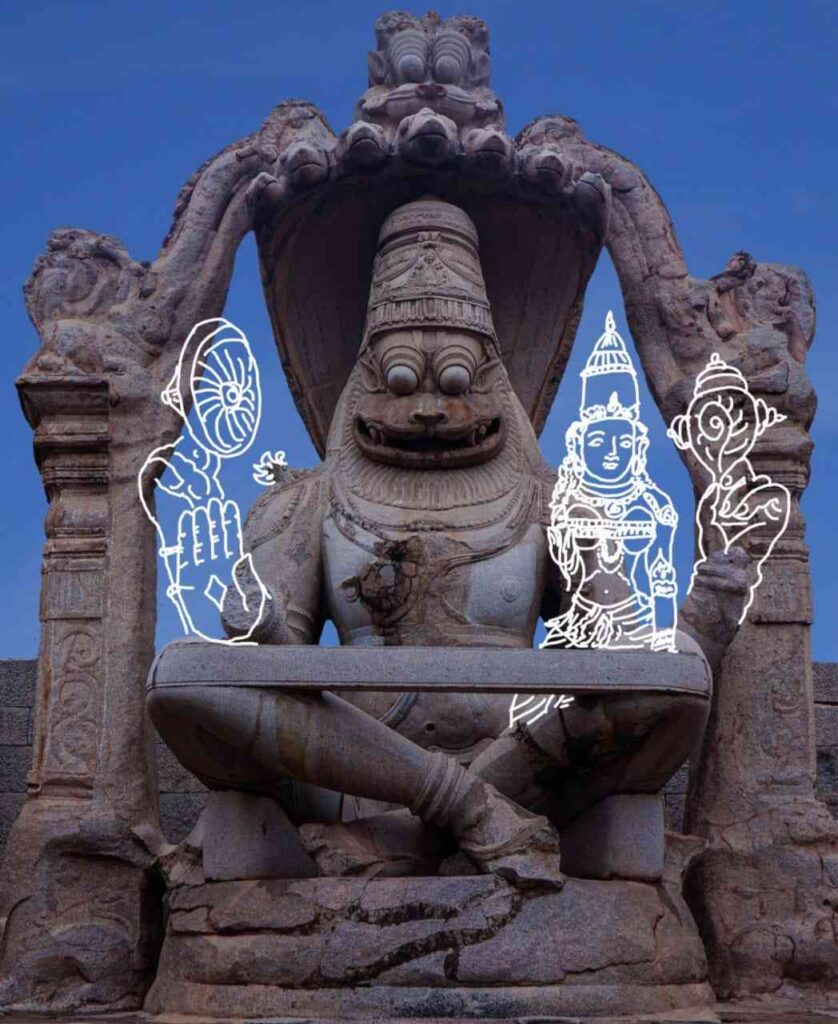
Ugra or Lakshmi Narasimha
The lion-faced Lakshmi Narasimha, also known as Ugra Narasimha (the ferocious Narasimha), is depicted in two different forms according to two theories about the statue. One theory proposes that the statue represents the Ugra Narasimha, characterized by its fierce appearance, with protruding eyes and a terrifying facial expression. The absence of Goddess Lakshmi beside the deity further supports this interpretation.
The other theory suggests that the statue portrays the Malola Narasimha form also known as Lashmi Narasimha. In this interpretation, Narasimha is depicted with his consort Goddess Lakshmi seated on his lap, although the figure of Lakshmi is now damaged. The term “Malola” is derived from “Ma,” meaning Goddess Lakshmi, and “Lola,” meaning husband who is engrossed in her or beloved.
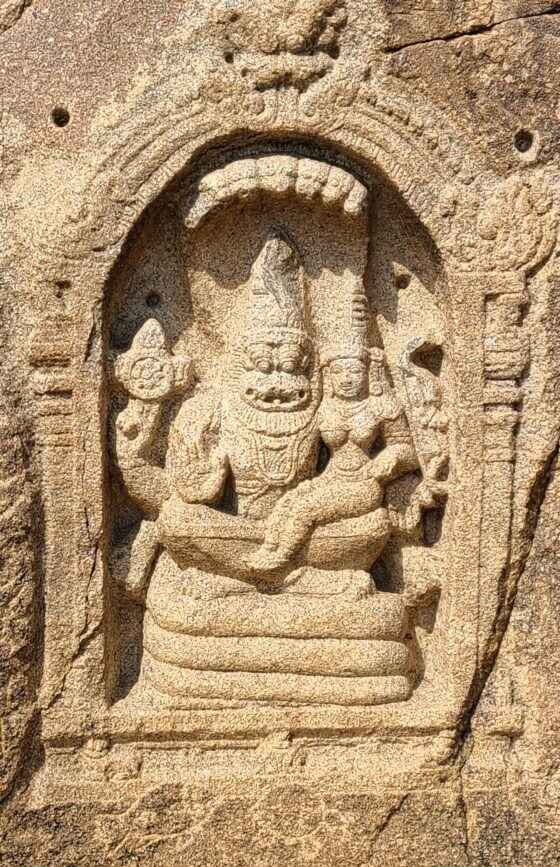
Must-see things in Lakshmi Narasimha temple
In the heart of Hampi, a place overflowing with ancient wonders, lies a temple dedicated to a powerful form of Lord Vishnu – the Lakshmi Narasimha Temple. Step back in time and prepare to be awestruck by its majesty! This temple isn’t just any historical site; it’s a treasure trove waiting to be explored. But before you embark on this exciting journey, let’s peek inside and discover the must-see things that will leave you speechless:
The Lakshmi Narasimha statue: This iconic monolithic statue depicts Lord Narasimha, an incarnation of Lord Vishnu. The statue is one of the largest and most impressive monolithic sculptures in Hampi.
Surrounding landscape: Take in the breathtaking views of the Hampi ruins and the surrounding landscape from the elevated vantage point of the temple premises. Witness the beauty of the rugged terrain and the ancient ruins that dot the landscape, offering a glimpse into Hampi’s glorious past.
Spiritual ambiance: Experience the serene atmosphere and spiritual ambiance of the temple complex as you soak in the tranquility of the surroundings. Whether you’re seeking solace or simply admiring the architectural marvels, the Lakshmi Narasimha Temple offers a peaceful retreat for spiritual contemplation.
Historical significance: Learn about the historical significance of the Lakshmi Narasimha Temple and its role in the Vijayanagara Empire. Discover the legends and stories associated with the deity and the temple complex, adding depth to your visit and enriching your understanding of Hampi’s cultural heritage.
The story of Narasimha
The mythology of Lakshmi Narasimha, also known as Ugra Narasimha, is deeply rooted in Hindu tradition and is primarily narrated in the ancient scriptures like the Vishnu Purana and the Bhagavata Purana. The story of Narasimha, the fourth avatar of Lord Vishnu, is one of the most revered tales in Hindu mythology. Below is a brief retelling of the mythological tale:
Hiranyakashipu’s Boon:
The story begins with a demon king named Hiranyakashipu. Through intense austerities, he gained a powerful boon from the god Brahma. This boon made him practically invincible – he could not be killed by a man, animal, or weapon during the day or night, indoors or outdoors. Fueled by his newfound power, Hiranyakashipu became arrogant and declared himself the supreme god. He persecuted anyone who dared to worship Vishnu, especially his own son, Prahlada, a devout follower of Vishnu.
Prahlada’s Devotion:
Hiranyakashipu’s son, Prahlada, was a devoted follower of Lord Vishnu despite his father’s commands. Prahlada’s unwavering devotion angered Hiranyakashipu, who attempted to kill his own son multiple times, but Prahlada remained unharmed due to Vishnu’s divine protection.
Narasimha’s Emergence:
Finally, Hiranyakashipu challenged Prahlada to prove the existence of Vishnu. Prahlada declared that Vishnu was present everywhere, even in the pillar of their palace. In a fit of rage, Hiranyakashipu struck the pillar, and from it emerged Narasimha – a half-man, half-lion form of Vishnu.
The Battle:
Narasimha, being neither man nor beast, and thus not bound by Brahma’s boon, attacked Hiranyakashipu at dusk, on the threshold of a courtyard, using his claws. A fierce battle ensued between Narasimha and Hiranyakashipu, during which Narasimha finally defeated the demon king.
The Role of Lakshmi:
While Narasimha had successfully vanquished the evil king, his rage continued to burn fiercely. Vishnu’s consort, Lakshmi, took the form of Lakshmi Narasimha – a serene woman adorned with flowers. She sat on Narasimha’s lap and gently calmed his rage, restoring peace.
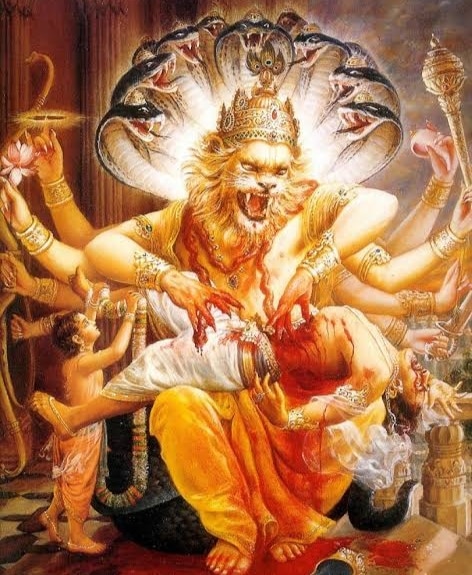
Gallery:-


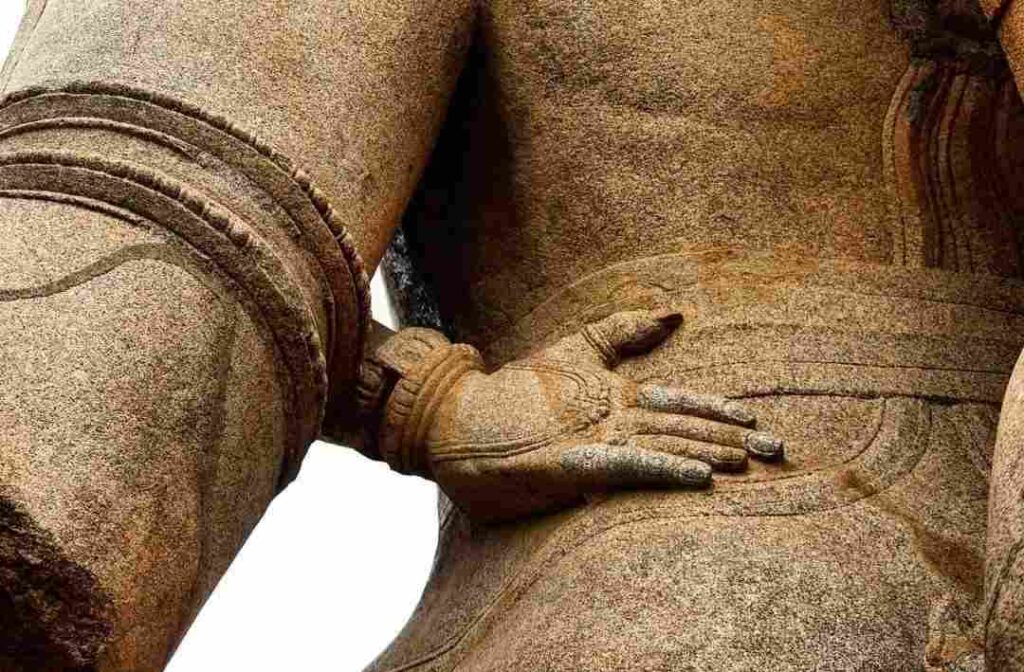

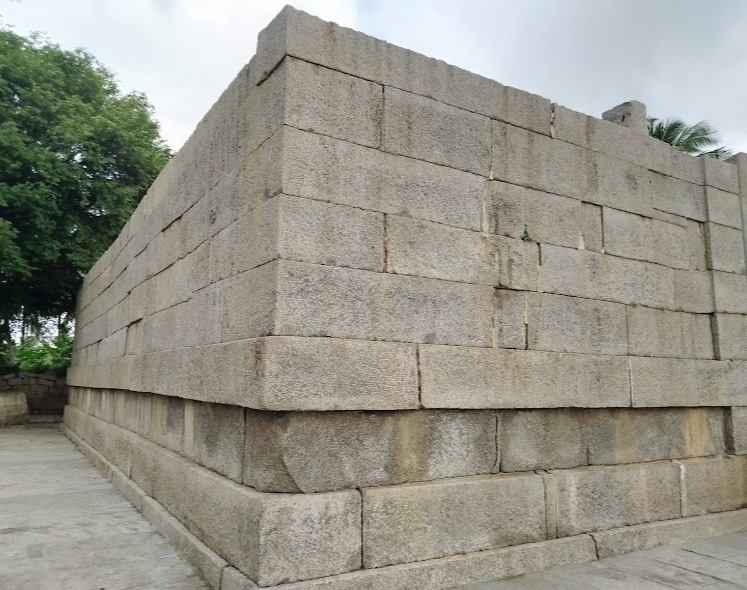
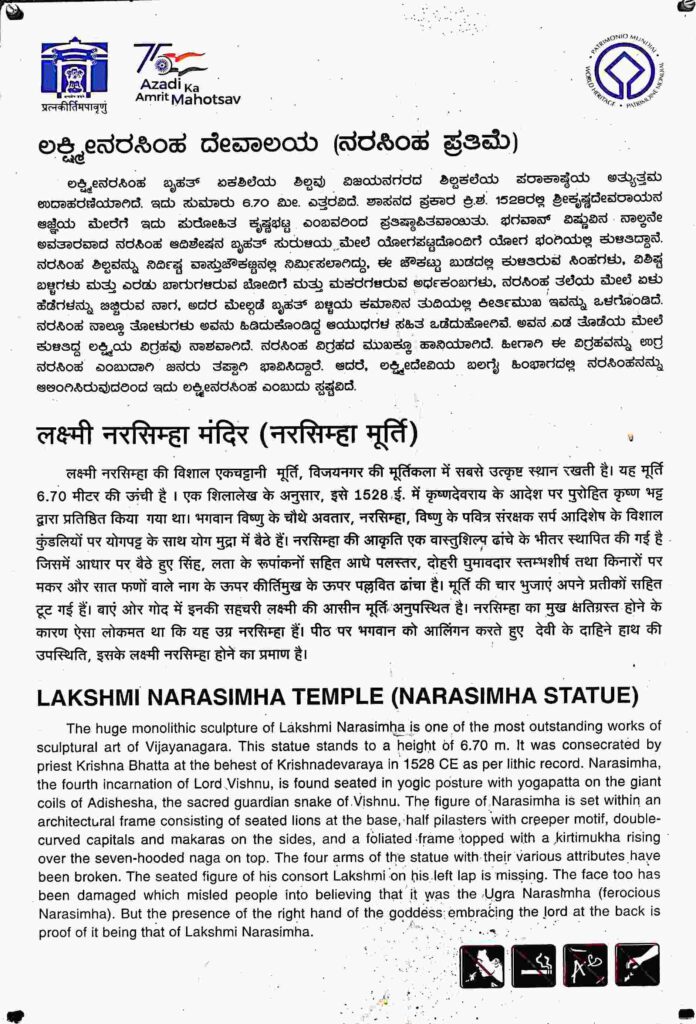
References:-
References from the Following Sources;